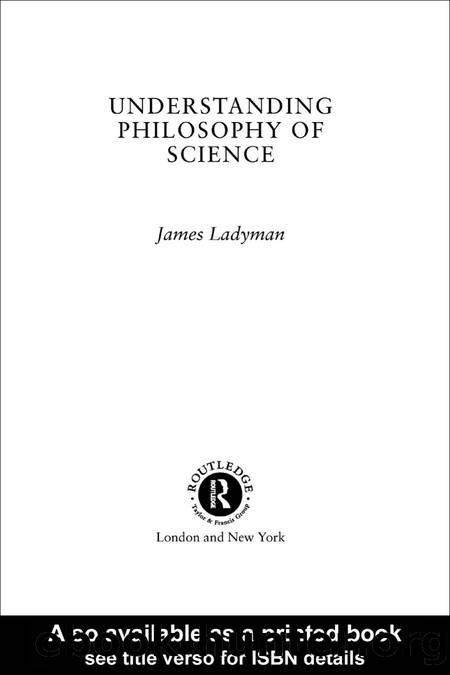James Ladyman by Understanding Philosophy of Science-Routledge (2002)

Author:Understanding Philosophy of Science-Routledge (2002)
Language: eng
Format: mobi
Published: 0101-01-01T00:00:00+00:00
In Chapter 4, I discussed the idea of theory-laden observation. Recent empirical work seems to suggest that what we see is, at least in part, constructed by our brains, rather than being simply an image transmitted from the retina. So, for example, it has been found that if someone is given a pair of spectacles with lenses that turn everything upside down, then at first they will be quite unable to see properly.
However, after a while, their brain will adapt and they will start seeing everything the right way up again. Then if the spectacles are later removed, the world will look upside down again until the brain readjusts.
The doctrine that the immediate or direct objects of perception are ideas in the mind, rather than objects in the external world was called ideaism by Alan Musgrave (1993) (not to be confused with idealism, of which more later).
Ideaism: We do not directly perceive external objects but rather our mindsâ own ideas or representations of the world.
This was the theory held by the British empiricists, Locke, Berkeley and Hume, who have done so much to influence philosophy of science. According to these thinkers, the mind is not directly aware of objects in the world at all, but rather of what they called âideasâ and
âimpressionsâ: Locke says the mind âhath no other immediate object but its own ideasâ (Locke 1964: Book IV, i, I); Berkeley says âthe objects of human knowledge are either ideas actually imprinted on the senses, or else such as are perceived by attending to the passions and operations of the mindâ (Berkeley 1975: Part I, I); and Hume says
â[a]ll the perceptions of the human mind resolve themselves into impressions and ideasâ (Hume 1978: I,i,I). A twentieth century version of ideaism was maintained by Alfred Ayer (1910â1989) who said, âone can directly experience only what is private to oneselfâ (Ayer 1940: 136). (These supposed immediate objects of experience are what many twentieth century philosophers used to call âsense-dataâ; they are also sometimes called âthe givenâ.)
All of the British empiricists thought that there were basically two types of mental objects or ideas, namely those that are produced by the senses and the emotions, and those that are copies or faint images of the former. It is best to take Humeâs terminology because he distinguishes between âimpressionsâ and âideasâ, to make this distinction clear; hence, the impression of red is what is forced on the mind by the senses, whereas the idea of red is the image of that impression that one can bring before the mind at will. Similarly, the impression of anger is the feeling that one has when one is angry, whereas the idea of anger is the faint copy of that impression which is before the mind when one thinks about anger.
Ideaism contradicts direct realism, but not the part of the latter that says that there are external objects. Ideaism is a thesis about the nature of perception, not a metaphysical thesis about what exists.
Hence, ideaism is compatible with metaphysical realism.
Download
This site does not store any files on its server. We only index and link to content provided by other sites. Please contact the content providers to delete copyright contents if any and email us, we'll remove relevant links or contents immediately.
The remains of the day by Kazuo Ishiguro(8830)
Tools of Titans by Timothy Ferriss(8225)
Giovanni's Room by James Baldwin(7199)
The Black Swan by Nassim Nicholas Taleb(7016)
Inner Engineering: A Yogi's Guide to Joy by Sadhguru(6728)
The Way of Zen by Alan W. Watts(6512)
Asking the Right Questions: A Guide to Critical Thinking by M. Neil Browne & Stuart M. Keeley(5654)
The Power of Now: A Guide to Spiritual Enlightenment by Eckhart Tolle(5610)
The Six Wives Of Henry VIII (WOMEN IN HISTORY) by Fraser Antonia(5398)
Astrophysics for People in a Hurry by Neil DeGrasse Tyson(5134)
Housekeeping by Marilynne Robinson(4349)
12 Rules for Life by Jordan B. Peterson(4250)
Double Down (Diary of a Wimpy Kid Book 11) by Jeff Kinney(4209)
The Ethical Slut by Janet W. Hardy(4178)
Skin in the Game by Nassim Nicholas Taleb(4165)
Ikigai by Héctor García & Francesc Miralles(4125)
The Art of Happiness by The Dalai Lama(4063)
Skin in the Game: Hidden Asymmetries in Daily Life by Nassim Nicholas Taleb(3935)
Walking by Henry David Thoreau(3897)
